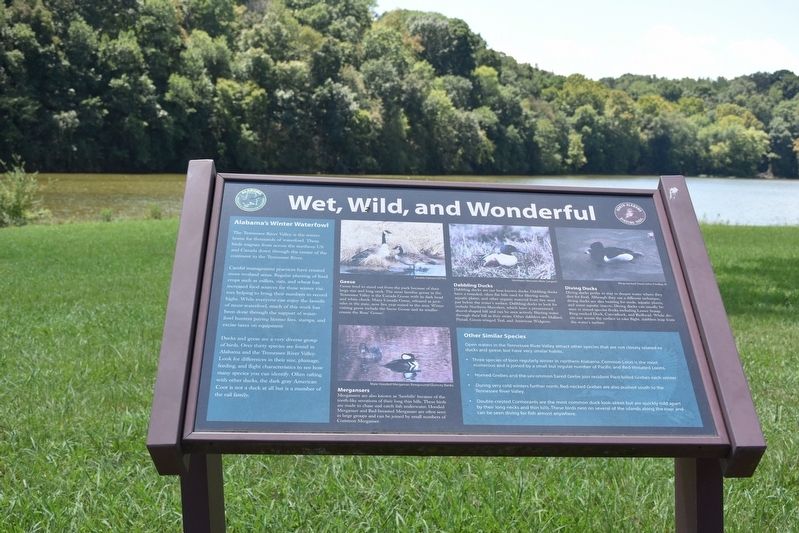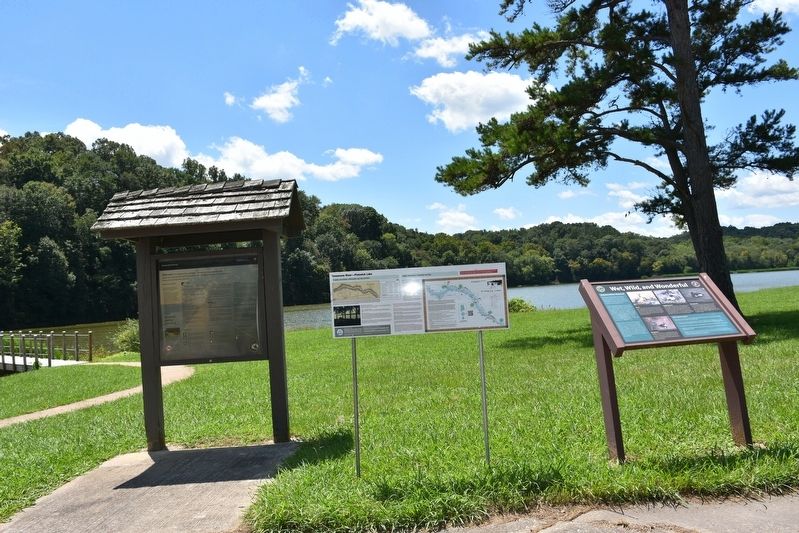Cherokee in Colbert County, Alabama — The American South (East South Central)
Wet, Wild, and Wonderful
The Tennessee River Valley is the winter home for thousands of waterfowl. These birds migrate from across the northern US and Canada down through the center of the continent to the Tennessee River.
Careful management practices have created more wetland areas. Regular planting of food crops such as millets, oats, and wheat has increased food sources for these winter visitors helping to bring their numbers to record highs. While everyone can enjoy the benefit of more waterfowl, much of this work has been done through the support of waterfowl hunters paying license fees, stamps, and excise taxes on equipment.
Ducks and geese are a very diverse group of birds. Over thirty species are found in Alabama and the Tennessee River Valley. Look for difference in their size, plumage, feeding, and flight characteristics to see how many species you can identify. Often rafting with other ducks, the dark gray American Coot is not a duck at all but is a member of the rail family.
Geese
Geese tend to stand out from the pack because of their large size and long neck. The most familiar goose in the Tennessee Valley is the Canada goose with its dark head and white cheek. Many Canada geese, released as juveniles in the state, now live year-round in the area.
Mergansers
Mergansers are also known as “Sawbills” because of the tooth-like serrations of they long thin bills. These birds are made to chase and catch fish underwater. Hooded Merganser and Red-breasted Mergansers are often seen in large groups and can be joined by small numbers of Common Mergansers.
Dabbling Ducks
Dabbling Ducks are our best-known ducks. Dabbling Ducks have a rounded, often flat bills used for filtering seeds, aquatic plants, and other organic materials from fine mid just below the water’s surface. Dabbling Ducks to look of r include Northern Shovelers, which have a pronounced shovel-shaped bill and can be seen actively filtering water through their bill as they swim. Other dabblers are Mallard, Pintail, Green-winged Teal, and American Widgeon.
Diving Ducks
Diving Ducks prefer to stay in deeper water where they dive for food, Although they use a different technique, diving ducks are also hunting for seeds, aquatic plants and some aquatic insects. Diving ducks can usually be seen in mixed species flocks including Lesser Scaup, Ring-necked Ducks, Canvasback, and Redhead. While divers run across the surface to take flight, dabblers leap from the water’s surface.
Other Similar Species
Open waters in the Tennessee River Valley attract other species that are not closely related to ducks and geese, but have very similar habits.
• Three species of loon regularly winter in northern Alabama. Common Loon is the most numerous and is joined by a small but regular number of Pacific and Red-throated Loons.
• Horned Grebes and the uncommon Eared Grebe join resident Pied-billed Grebes each winter.
• During very cold winters further north, Red-necked Grebes are also pushed south to the Tennessee River Valley.
• Double-crested Cormorants are the most common duck lookalikes but are quickly told apart by their long necks and thin bills. These birds nest on several of the islands along the river and can be seen diving for fish almost anywhere
Erected by Alabama Wildlife & Freshwater Fisheries North Alabama Birding Trail.
Topics and series. This historical marker is listed in these topic lists: Animals • Environment. In addition, it is included in the Natchez Trace series list.
Location. 34° 50.388′ N, 87° 56.692′ W. Marker is in Cherokee, Alabama, in Colbert County. Marker can be reached from Natchez Trace Parkway (at milepost 327.3), 1.6 miles N Pike (County Route 21), on the left when traveling east. Located in Natchez Trace Parkway Colbert Ferry Park near Bird site #12 and the Natchez Trace Boat Ramp. Touch for map . Marker is in this post office area: Cherokee AL 35616, United States of America. Touch for directions.
Other nearby markers. At least 8 other markers are within walking distance of this marker. Welcome! (within shouting distance of this marker); Safe Crossing (approx. 0.2 miles away); Colbert Ferry (approx. 0.2 miles away); George Colbert Memorial (approx. 0.2 miles away); Colbert's Stand (approx. 0.2 miles away); Chickasaw Hospitality (approx. ¼ mile away); A Chickasaw Planter (approx. ¼ mile away); Trace Travelers (approx. 0.4 miles away). Touch for a list and map of all markers in Cherokee.
Credits. This page was last revised on August 21, 2017. It was originally submitted on August 20, 2017, by Sandra Hughes Tidwell of Killen, Alabama, USA. This page has been viewed 490 times since then and 39 times this year. Photos: 1, 2. submitted on August 20, 2017, by Sandra Hughes Tidwell of Killen, Alabama, USA. • Bernard Fisher was the editor who published this page.

